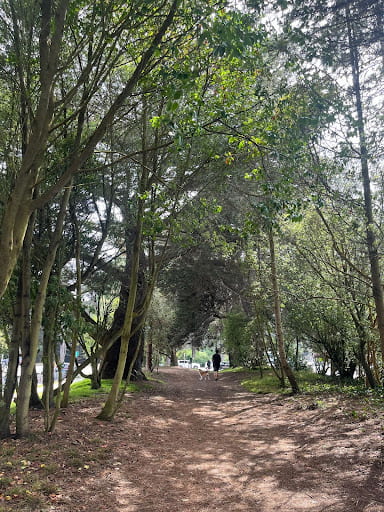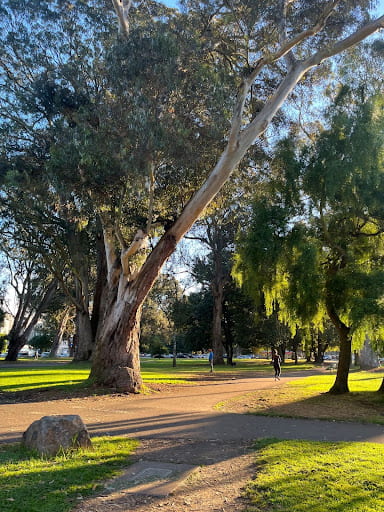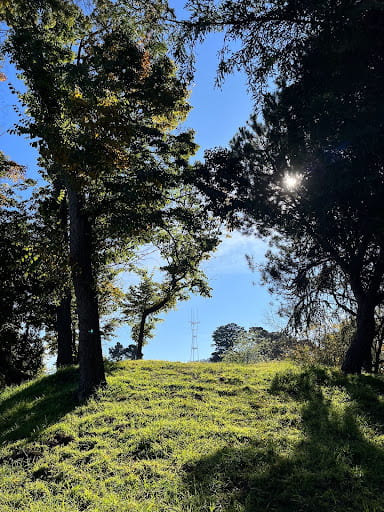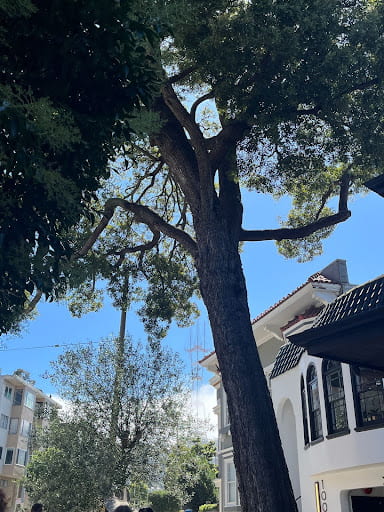Befriending San Francisco’s Urban Forest
Do you too find peace beneath the trees?
Do you seek comfort under canopies of green?
Maybe you’re also a friend of the forest around us.
If you consider yourself a friend of the trees, you’ll be happy to know that San Francisco’s urban forest is quite impressive with around 669,000 trees (including street trees, park trees, and others) integrated into San Francisco’s built environment. That means roughly 11.9% percent of the City is shaded by canopy cover (Nowak et al., 2007)! For a dense and highly developed city, that figure is incredibly impressive to me. San Francisco clearly prioritizes their urban ecology, and as we know how beneficial trees are for ecological health (but if you don’t, I will cover that later, no worries), an investment in urban ecology is also an investment in ecological health. However, this figure is also impressive considering San Francisco’s native ecosystem types do not particularly welcome trees. The sand dunes, grasslands, and wetlands that formerly dominated the peninsula didn’t include eucalyptus or coastal cyprus, for example. At the same time, our urban ecology (and what we decide to plant) is important in the way that it flourishes beneath an understory of skyscrapers and is built into a soil of sidewalk. So yes, San Francisco’s urban forest is an ironic consequence of development, but it is also so important to the life that lives on this special peninsula.
One tree is a powerful thing. A whole forest of trees is even greater. The benefits of urban forests are well understood with a plethora of social, economic, and environmental positives. A tree’s ability to sequester carbon is key in urban environments where high concentrations of CO2 are emitted in small areas. Trees capture this carbon and other pollutants to improve air quality, which, of course, is helpful for human health. Trees also help to reduce the “urban heat island” effect and to cool dense areas, a useful tool in attempting to fight climate change and global warming. Other environmental benefits include reducing stormwater runoff, decreasing noise pollution, and providing wildlife habitat.
Perhaps you’ve traveled on 19th Avenue, a.k.a. Park Presidio Boulevard, here in San Francisco? This is a great example of the urban forest’s positive impact on San Francisco’s ecology. Park Presidio Boulevard is a heavily trafficked arterial road on the west side of the city that is designed to efficiently funnel a massive amount of vehicles through the city. As I’m sure you’ve experienced or can imagine, it’s quite a stressful place to be, but the forested greenbelts on either side of the roadway bring a sense of peace to the area. The trees shade safe walking paths free of the dangerous threat that traffic presents and reduce noise pollution on either side of the roadway. And my favorite benefit of all, the Park Presidio Boulevard greenbelt provides a path for coyotes and other wildlife through the city as a part of the Green Connections Initiative. If you want to learn more about the Green Connections Network and how it facilitates biodiversity in the city, check out my blog post about it!

Beyond their important environmental impacts, trees also beautify neighborhoods and transform the aesthetic appeal of communities, which may sound positive but isn’t always a good thing. Urban greening is directly associated with gentrification and the increase in property value. In fact, SF Planning boasts how there is a $98,272,878 annual increase in property values provided by San Francisco’s trees. Additionally, healthy mature trees in front of homes have been shown to increase property values for residential properties. These facts explain the hesitation of some communities to welcome trees onto their streets and display the importance of stewarding urban forests in a community-informed way, or a way that understands and acknowledges community concerns. Gentrification is a generationally-traumatic event that results in a mistrust of community outsiders and their intentions from communities that have been historically pushed out or excluded from their spaces. This experience must be thoughtfully considered when NGOs and the government approach communities with urban greening initiatives. Interestingly, the communities in San Francisco with the lowest canopy cover rates are historically redlined neighborhoods and low-income communities of color. This complexifies the importance of community-informed planting when most urban greening efforts are targeting areas with low canopy cover.
I’ve recently taken a great interest in San Francisco’s urban forest since joining the Friends of the Urban Forest’s Community Forester Program. If you think you don’t know the Friends of the Urban Forest (FUF), then think again. FUF is responsible for the planting of over half of the street trees in San Francisco – their presence is hard to ignore when walking around the city with all the trees that bear their logo. Friends of the Urban Forest is an NGO contracted by the City to plant street trees and care for them for the first three years of their lives. After those three years, the responsibility is transferred to the Department of Public Works through StreetTreeSF.
San Francisco’s recent urban forest related policies are incredibly interesting to me as examples of cutting edge municipal environmental policy. In the Fall of 2014, the Urban Forest Plan was released which completely changed the game on trees in San Francisco. The Urban Forest plan identifies policies and strategies to manage the City’s tree population. The plan, which identifies key issues facing street trees, also provides recommendations and policy framework to grow, support, and manage initiatives to improve the urban forest of San Francisco. The Plan’s first phase, Street Trees, is in motion with StreetTreeSF, which works with Friends of the Urban Forest closely! I think it’s so interesting that the City and CBOs work together so closely to tackle this endeavor together.
I’ve learned so much through the FUF Community Forester Program that is designed to train stewards, leaders, and allies of the Urban Forest and to sustain the organization for years to come. I’ve also changed my perspective on San Francisco’s urban ecology in the process. If you find yourself at peace beneath the trees and appreciate their shade and environmental benefits, consider working with Friends of the Urban Forest or any other urban forest initiative in San Francisco!
Sources
Nowak et al. Assessing Urban Forest Effects and Values, San Francisco’s Urban Forest. 2007, https://doi.org/10.2737/NRS-RB-8
San Francisco Urban Forest Plan. https://sfplanning.s3.amazonaws.com/default/files/plans-and-programs/planning-for-the-city/urban-forest-plan/UFP_SFUrbanForestOverview.pdf
Public Works. San Francisco Urban Forest Plan. https://sfpublicworks.org/services/urban-forest-plan
Public Works. Green Connections Ecology Guide. https://default.sfplanning.org/Citywide/green_connections/GC_RouteEcologyGuides_Final.pdf





